Distance Teaching
> Matthewcarter
How to Make the Most of Student Feedback During Distance Learning. As teachers, we constantly look for clues that can help us understand the impact of our decisions.
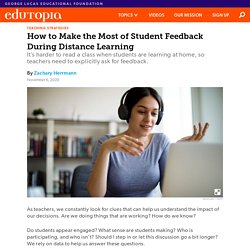
Are we doing things that are working? How do we know? Do students appear engaged? What sense are students making? Who is participating, and who isn’t? When I’m teaching in a physical classroom, the data seems rich and abundant. This rich, analog data stream from my in-person classroom has turned into a multichannel digital data stream in my virtual classroom. I’m left with questions for which I have little data to support any answers. In my efforts to get more visibility into what is actually happening in my virtual classroom, I created new routines for gathering, analyzing, and using feedback. 5 Ideas for Using Feedback Well This Year 1. Since I created this feedback form, I’ve gathered thousands of data points that help me better understand my own teaching, as well as my students’ learning. 2.
However, students didn’t agree on everything. 3. 4. 5. I have experienced each of these triggers.
Strategies K-12 Teachers Can Use to Work Efficiently When Teaching Online. Teaching in a hybrid in-person/remote model requires significantly more planning than teaching in the traditional classroom model.
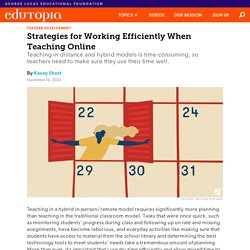
Tasks that were once quick, such as monitoring students’ progress during class and following up on late and missing assignments, have become laborious, and everyday activities like making sure that students have access to material from the school library and determining the best technology tools to meet students’ needs take a tremendous amount of planning. More than ever, it’s important that I use my time efficiently and allow myself time to recharge. Organizing Tasks Given the variety of tasks that I need to complete, I create a detailed, handwritten list every Friday. I divide it into four parts (Long-Term Goals, Do Now, Creating, and Doing), which helps me to stay organized and use my time more effectively.
By organizing tasks into sections, I can clearly see if I have a lot of the same type of tasks and then tackle them at the same time. Plan for Breaks. Strategies to Encourage Middle and High School Students to Turn Their Cameras On. While there is a tremendous amount of value to being able to see your students’ faces during distance learning, we can’t force them to be on camera, just as during in-person teaching, we can’t force unengaged students to lift their heads or remove hats or hoodies that obscure their faces.

With experimentation and persistence, however, you can arrive at strategies that work. Whether they need options, encouragement, or trust in order to turn their cameras on, there’s likely a solution that is the right fit for your classroom, circumstances, lessons, and students. SEL Strategies to Encourage Camera Use If you want to incorporate social and emotional learning (SEL) strategies to prompt camera use among your students, start with the recognition that words matter: Our communication with our students needs to be rooted in community, not compliance. From there, you could leverage any number of SEL approaches. Build relationships. Survey students. Use icebreakers. Play games.
Teaching Resources Hub. Asia Society's China Learning Initiatives team is pleased to curate an evolving hub of resources, tools, and perspectives to help educators succeed in this challenging time.
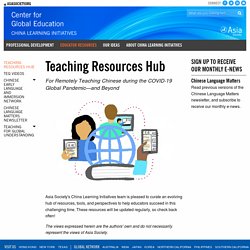
These resources will be updated regularly, so check back often! The views expressed herein are the authors' own and do not necessarily represent the views of Asia Society.
Revisiting Blended Learning Principles, With School Plans in Limbo. This fall, some school buildings may be open again, but things won’t be back to normal.

In all likelihood, students will have to come to campuses part-time in shifts, which creates a whole host of challenges for schools as they strive to offer comprehensive educational opportunities. Designing a new choreography for schooling may seem like a huge undertaking, but it’s not a new one. For the better part of a decade, many schools have been implementing blended learning models that integrate online learning with brick-and-mortar instruction to rethink time, space and staffing.
Preventing Covid Infections
Here’s the Syllabus for Your Summer Crash Course in Online Education. Summative Assessment in Distance Learning. All of us are challenged with trying to implement effective teaching in this distance learning environment, and assessment is certainly part of that.

Many schools are wrestling with grading practices, with some choosing pass/fail structures and others are sticking with traditional grading practices. And of course, there are others who are somewhere in between. But all of us will need summative assessments of student learning, whether we report them as a grade or pass/fail. It’s important that we not rely solely on tried-and-true summative assessment practices and strategies during this time—we should reflect on those practices and strategies and approach assessment differently. Some of our practices may shift.
4 Key Aspects of Teaching a K–12 Online Class. Building a successful virtual learning program can help teachers and students grow.
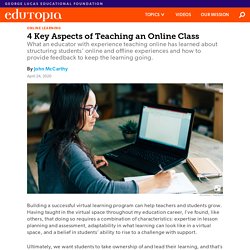
Having taught in the virtual space throughout my education career, I’ve found, like others, that doing so requires a combination of characteristics: expertise in lesson planning and assessment, adaptability in what learning can look like in a virtual space, and a belief in students’ ability to rise to a challenge with support. Ultimately, we want students to take ownership of and lead their learning, and that’s even more necessary in a virtual space. Where physical classrooms offer face-to-face activities that the teacher can readily observe and monitor, in virtual classrooms students are physically separated from their peers and teacher, so teachers need to be very intentional about monitoring how students are doing. Here are key aspects of building a virtual learning culture that are discussed below: Develop an Offline Learning Plan for Students’ Independent Work. How to Forge a Strong Community in an Online Classroom. When I moved a large part of my curriculum online a decade ago, I had to become more flexible and creative in my teaching.
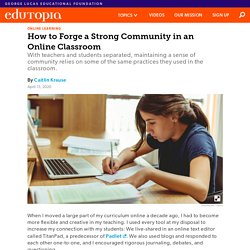
I used every tool at my disposal to increase my connection with my students: We live-shared in an online text editor called TitanPad, a predecessor of Padlet. We also used blogs and responded to each other one-to-one, and I encouraged rigorous journaling, debates, and questioning.
4 Guiding Questions for Effective Remote Collaboration in School Teams.
Shelter-in-place, self-quarantine, and stay-at-home orders have created a new reality for educators, students, and families.
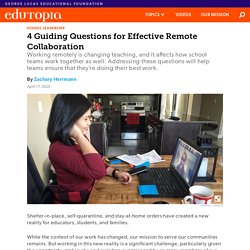
While the context of our work has changed, our mission to serve our communities remains. But working in this new reality is a significant challenge, particularly given the uncertainty, ambiguity, and isolation experienced by so many members of our communities. So how do we respond to these challenges? Much of our work as educators happens in teams. Teamwork has traditionally played a critical role in schools, and while many of us find ourselves physically isolated, our collaborative work with one another may be more important now than ever.
National Museum of American History. How to Make Effective Videos for Learning. 5 Teaching Strategies of Award-Winning Online Instructors. The spring of 2020 has brought a sudden shift for many classrooms into an online setting.
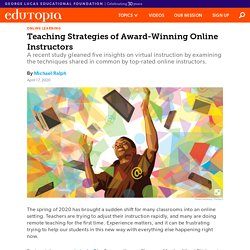
Teachers are trying to adjust their instruction rapidly, and many are doing remote teaching for the first time. Experience matters, and it can be frustrating trying to help our students in this new way with everything else happening right now. Fortunately, a recent study by Swapna Kumar, Florence Martin, Albert Ritzhaupt, and Kiran Budhrani in the open-access journal Online Learning shares the stories of a group of eight award-winning online instructors with a combined 109 years of experience teaching online courses. The study authors interviewed university-level instructors about their approaches to online instruction. These approaches apply to K–12 students as well, because the instructors emphasize things like relevant course materials, a flexible approach to student work, and the importance of reflection in learning—all things we need in elementary and secondary education, too.
A Renewed Case for Student Success: Using Transparency in Assignment Design When Teaching Remotely.
In response to the worldwide spread of COVID-19, most erstwhile face-to-face and hybrid courses have now transitioned into remotely delivered ones. In these new educational spaces, designing for student success poses some specific challenges, especially because many faculty have had to plan and design to teach remotely at relatively short notice. While instructional designers and technologists are doing their best to help faculty transition to remote teaching during this challenging time, there appears to be relatively little discussion about designing courses for maximizing student success.
Edtech Research that Informs Action & Builds Community. Resources in Response to COVID-19. Many of you have either made the transition to an online learning environment or are in the process of doing so. Under normal circumstances, this doesn’t happen overnight, yet that’s what is being asked of you. Remember that many of your colleagues have been doing this for years and have gone through countless trainings.
It’s ok to have lowered expectations—not of your students but of yourself. In unprecedented times like these, the sharing of resources is going to play a critical role in our collective success. In this spirit, ACTFL would like to show its unwavering support for the profession by offering the following: A FREE 1-year basic membership to any new member who joins ACTFL between now and June 30, 2020.
Language Resource Center - at Columbia University.
Snow Day / Digital Learning Day










